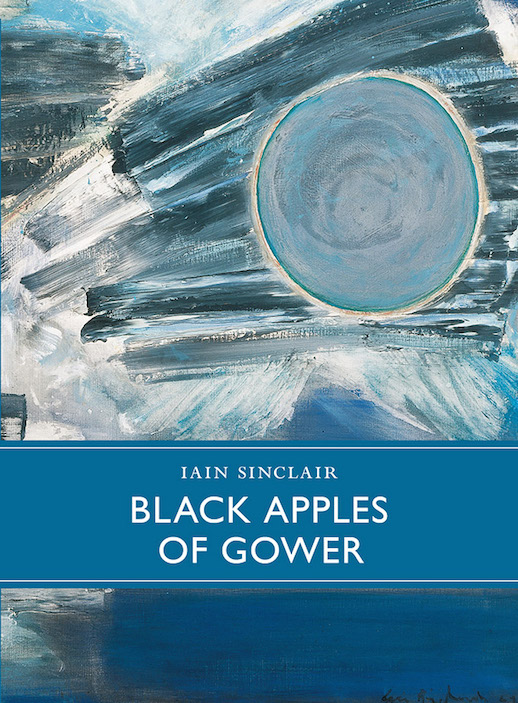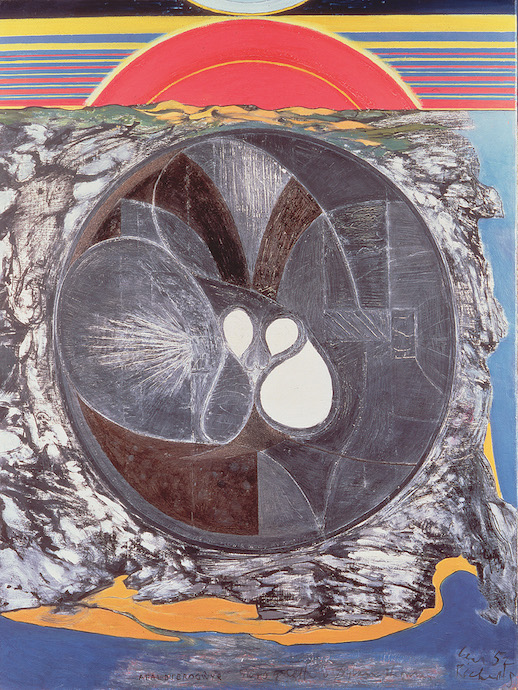Black Apples of Gower by Iain Sinclair
Little Toller Press, hardback, 184 pages. Out now
Review by Jon Gower
We’ve been to some places with this guy: circulating around the London Orbital, going downriver, or overground, not to mention putting the Lights Out for the Territory in that peerless and endlessly satisfying peregrination around London. Throughout his abundant output of novels and non-fiction, Iain Sinclair has been always been the most companionable and knowledgeable of guides: an archaeologist of the new, a forensic examiner of the urban. He usually sticks to London, hymning, say, the East End, or elegizing its changes, as when Olympic ambitions threatened to destroy community life. He walks, then writes with such vital and communicable curiosity – reading the graffito-runes written on walls, eagerly sharing information, seemingly always in the company of a ghostly legion of other writers and their thoughts. It’s as if he trundles a cart-load of books – like the ones he used to sell on his market stall – behind him, able to reach for the most apposite quote at any pause. He sometimes ventures beyond the M25, of course, as he did tracing the sad journey of the poet John Clare from Epping Forest to Northamptonshire, but London is his grand subject, and Sinclair one of the city’s most entertaining celebrants.
So it comes as some surprise to find him turning his attention to the cliffscapes and caves of Gower in south Wales, taking great lungfuls of the ozone-inflected sea air. But what a delightful surprise: here we have all the usual erudition and engaging digressions, but also a tentative, almost embarrassed sort of homecoming, as the 71 year old psycho-geographer and film-maker returns to a place he used to bicycle in his youth, all the way from his Maesteg home, in the company of two mates, happily camping and chasing girls. He also visited the self-same area for a second time in the 1970s, choosing at the time to eschew the glories and info of the OS map and finding his way around, rather, using William Blake’s ‘Mundane Egg’ diagram.
Even in his youth, and despite the ready glories of the countryside he visited, Sinclair was not a conventional lover of nature, as his preferred nature studies were ‘…abandoned tin works, landfill quarries, feeder pipes, slag heaps, rust-red streams, overgrown railway embankments, and not the approved catalogue of rabbits, hawks, herons, butterflies, beetles, spiders, mallow, rock spurrey and gentian’. He prefers human history to natural history, and this book is no departure from that allegiance.
The watchwords of the book are ‘Place is poem’ and Black Apples is a mantric, and entirely absorbing prose-poem which has, as its sinuous locus, the crinkled and crenellated coastlands of south Gower and, in particular, the bracing walk that connects Port Eynon to Worm’s Head. Along the way we have detailed observations of human impact on the landscapes, alongside entertaining speculations, such as the idea that one of the Ice age men of Gower ‘could have walked to Ireland, carrying the prophecy of the Mabinogion on his back, for presentation to James Joyce, Samuel Beckett and Flann O’Brien.’
The central and eponymous image of the book is the artist Ceri Richards’ “Afal Du Brogwyr”, one of the Dunvant-born painter’s many febrile and fantastical responses to the poems of his friend Dylan Thomas. The dark, sexual, if androgynous apple is a work that has, in turn, stimulated other poets, including Geoffrey Hill, who, like Sinclair, found himself addressing the complexities of his relationship with Wales in his densely allusional book Oraclau/Oracles. Both books are full of echoes, both visual and sonar, of other writers, other works. They connect with the artists’ own past and also to very long traditions.
Describing the black apple grown in the rich loam of Ceri Richard’s imagination, Sinclair offers us some lovely, juicy art criticism, describing this unnerving, opiate lump of nigredo as being a ‘…war shield, with La Tène Celtic embellishments, bellying towards the eye. And the shield of some implacable machine boring down in the rock. The decorations are sexual, suspended between fixed identities, male and female, testis and ovary. Night-seeds in a limestone pod.’ Later the same doomy painting melds uncomfortably into a story about one of Sinclair’s friends – newly diagnosed with testicular cancer – who looks at the apple but sees the dark shadows of a recent scan.
One of the many delights of the book is the generous allowance of visual images, from apposite paintings to photographs: Sinclair can tease information out of a seemingly mundane holiday snap with the same detective skills as Geoff Dyer. He also populates the pages of this beautifully produced book – the artefact in hand matching the richness of the intellectual content – with a great cast of eccentrics, not least the father of modern cremation, William Price of Llantrisant, who immolated his son Iesu Grist, or Jesus Christ. There’s William Buckland, too, the palaeontologist and coprophile who liked to do his field work in full academic robes. Utterly bonkers, Buckland claimed discovery of the so-called Red Lady, or, as Sinclair cheekily puts it, the lady-boy of Paviland, an ancient skeleton with red-ochre tinted bones, found in one of the Gower caves. Buckland, the Oxford don and theologian, when not potholing into history, liked nothing less than to cook up a veritable menagerie for his supper, from elephant trunks to panther parts, mice in batter or stewed mole and even, on one disgusting occasion, the preserved heart of a French king.
It’s been a good while since Sinclair turned his attention to his native Wales. It was when he constructed Landor’s Tower, his 2001 novel, which got him banned from the Hay Festival because of his depiction of the border town’s booksellers – and something to do with readers having to trudge through fields of cabbage stalks, I half-recall. Sinclair now feels that he has ‘forfeited all the advantages of birth, walked away from a bankable heritage’. This Welsh reader, for one, is very glad he’s walked back this way, back into Wales as the journey has reaped ample rewards. Black Apples of Gower, with its boundless erudition and often luxuriant prose, has a dark, ascorbic bite, lingering on the tongue just as surely as it does in the mind.
Black Apples of Gower is available in the Caught by the River shop, priced at £15.
Iain Sinclair will be appearing at Rough Trade East on Tuesday 21 July, discussing his other new book, London Overground: A Day’s Walk Around the Ginger Line with Quietus editor Luke Turner. More information here.

